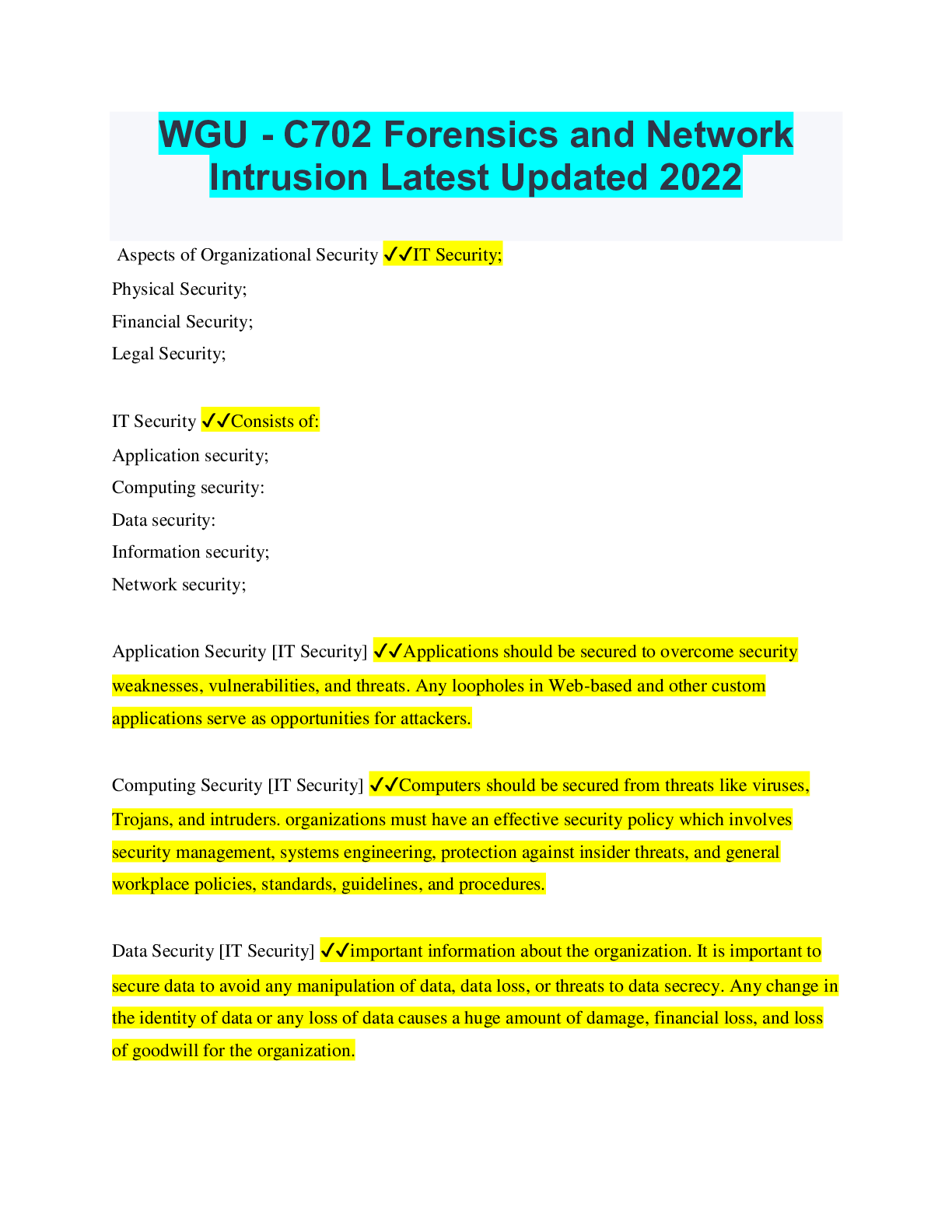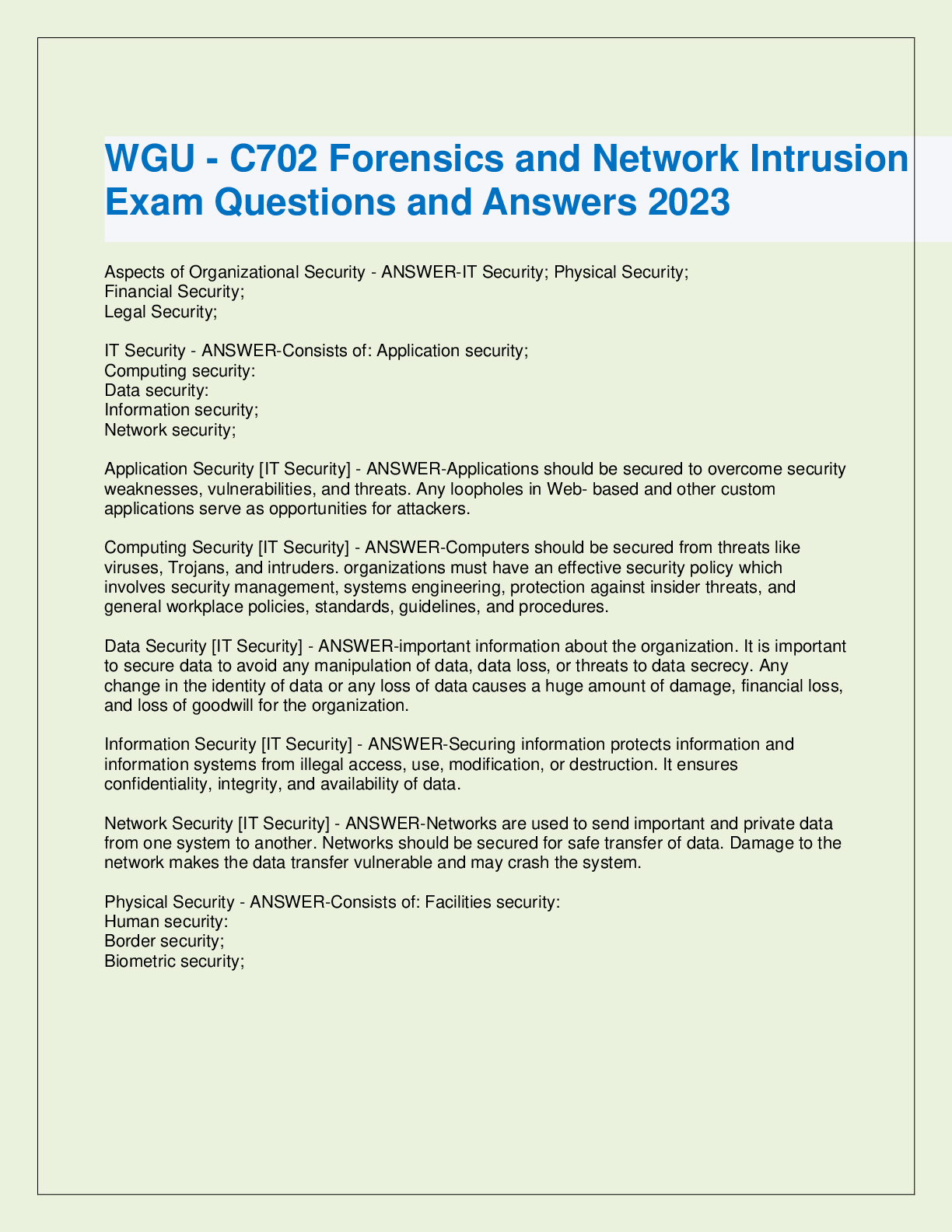Forensic Science > EXAM > WGU IT C702 Forensics and Network Intrusion 150 Questions & Answers,100% CORRECT (All)
WGU IT C702 Forensics and Network Intrusion 150 Questions & Answers,100% CORRECT
Document Content and Description Below
WGU IT C702 Forensics and Network Intrusion 150 Questions & Answers Q1. What must an investigator do in order to offer a good report to a court of law and ease the prosecution? A. prosecute the evid... ence B. obfuscate the evidence C. authorize the evidence D. preserve the evidence Q2. Which of the following is NOT a legitimate authorizer of a search warrant? A. magistrate B. court of law C. first responder D. concerned authority Q3. Which of the following is true regarding computer forensics? A. Computer forensics deals with the monetary cost of finding evidence related to a crime to find the culprits and initiate legal action against them. B. Computer forensics deals with the search for evidence related to a digital crime, but the forensics specialist does not need to be concerned about the legal admissibility of the evidence they find. C. Computer forensics deals with the process of finding evidence related to a digital crime to find the culprits and initiate legal action against them. D. Computer forensics deals only with the process of finding evidence related to a digital crime and does not try to estimate the monetary damages caused by that crime. Q4. Which of the following is true regarding Enterprise Theory of Investigation (ETI)? A. It adopts an approach toward criminal activity as a criminal act. B. It adopts a holistic approach toward any criminal activity as a criminal operation rather than as a single criminal activity. C. It differs from traditional investigative methods, and is less complex and less time consuming. D. It encourages reactive action on the structure of the criminal enterprise. Q5. Which of the following is NOT an element of cyber crime? A. fast-paced speed B. smaller evidence in size C. anonymity through masquerading D. volatile evidence Q6. Which of the following is true of civil crimes? A. The initial reporting of the evidence is generally informal. B. Law enforcement agencies are responsible for collecting and analyzing evidence. C. The standards of proof need to be very high. D. A formal investigation report is required. Q7. Which of the following is NOT a consideration during a cyber crime investigation? A. presentation of admissible evidence B. value or cost to the victim C. collection of clues and forensic evidence D. analysis of digital evidence Q8. Which of the following should be considered before planning and evaluating the budget for the forensic investigation case? A. break down of costs into daily and annual expenditure B. current media coverage of high profile computer crimes C. past success rate as a measure of value D. use of outdated, but trusted, technologies Q9. Which of the following is NOT part of the Computer Forensics Investigation Methodology? A. Secure the evidence. B. Collect the evidence. C. Destroy the evidence. D. Assess the evidence. Q10. Which of the following is NOT where potential evidence may be located? A. thumb drive B. digital camera C. smart card D. processor Q11. Which of the following Federal Rules of Evidence governs proceedings in the courts of the United States? A. Rule 105 B. Rule 102 C. Rule 103 D. Rule 101 Q12. Which of the following Federal Rules of Evidence contains Rulings on Evidence? A. Rule 105 B. Rule 101 C. Rule 102 D. Rule 103 Q13. Which of the following is NOT a digital data storage type? A. magnetic storage devices B. optical storage devices C. flash memory devices D. quantum storage devices Q14. Which of the following is NOT a type of flash-based memory? A. Double-level cell (DLC) B. Single-level cell (SLC) C. Multi-level cell (MLC) D. Triple-level cell (TLC) Q15. Which of the following is unique to SSDs? A. spindle B. NAND chips C. read/write heads D. platters Q16. Which of the following is NOT used in the calculation of HDD density? A. area density B. bit density C. block density D. track density Q17 Which of the following is the correct number of bytes reserved at the beginning of a CD-ROM for booting a computer? A. 16,384 B. 32,768 C. 512 D. 256 Q18 Which of the following specifications is used as a standard to define the use of file systems on CD- ROM and DVD media? A. ISO 9431 B. ISO 6990 C. ISO 1349 D. ISO 9660 Q19 Which of the following ISO 9660 compliant portions of a compact disc describes the location of the contiguous root directory similar to the super block of the UNIX file system? A. the primary track sector B. the secondary volume descriptor C. the primary volume descriptor D. the secondary track sector Q20 Which field type refers to the volume descriptor as a primary? A. Number 3 B. Number 1 C. Number 2 D. Number 0 Q21 Which field type refers to the volume descriptor as a partition descriptor? A. Number 2 B. Number 0 C. Number 3 D. Number 1 Q22 Which field is the standard identifier set to CD001 for a CD-ROM compliant to the ISO 9660 standard? A. third B. fourth C. second D. first Q23 What partition holds the information regarding the operating system, system area, and other information required for booting? A. extended partition B. tertiary partition C. primary partition D. secondary partition Q24 In MS-DOS and earlier versions of Microsoft Windows, which partition must be first and a primary partition? A. (C:) B. (B:) C. (A:) D. (D:) Q25 Which of the following is a data structure situated at sector 1 in the volume boot record of a hard disk to explain the physical layout of a disk volume? A. Boot Parameter Block (BPB) B. BIOS Parameter Block (BPB) C. Primary Sequential Sector (PSS) D. Primary Reserved Sector (PRS) Q26 MBR almost always refers to the partition sector of a disk also known as: A. Primary boot record (PBR) B. 512-byte boot sector C. 256-byte boot sector D. First boot record (FBR) Q27 How large is the partition table structure that stores information about the partitions present on the hard disk? A. 32-bit B. 32-byte C. 64-bit D. 64-byte Q28 Which of the following UNIX/Linux commands can be used to help backup and restore the MBR? A. BB B. FDISK C. DD D. CP Q29 GUIDs are displayed as how many hexadecimal digits with groups separated by hyphens? A. 64 B. 128 C. 32 D. 256 Q30 What is a standard partitioning scheme for hard disks and part of the Unified Extensible Firmware Interface? A. UEFI Partition Table (UPT) B. Universal Partition Table (UPT) C. General Partition Table (GPT) D. GUID Partition Table (GPT) Q31 How many bytes is each logical block in GPT? A. 256 B. 128 C. 512 D. 1024 Q32 What is the last addressable block where negative addressing of the logical blocks starts from the end of the volume in GPT? A. -255 B. -1 C. 0 D. 255 Q33 Which LBA stores the protective MBR? A. LBA 2 B. LBA 3 C. LBA 0 D. LBA 1 Q34 In the GUID Partition table, which Logical Block Address contains the Partition Entry Array? A. LBA 2 B. LBA 0 C. LBA 3 D. LBA 1 Q35 Which LBA will be the first usable sector? A. LBA 36 B. LBA 33 C. LBA 35 D. LBA 34 Q36 Which position does the protective MBR occupy in the GPT at Logical Block Address 0? A. Second B. first C. last D. third Q37 Which of the following describes when a user plugs in a computer and starts it from a fully off condition? A. warm booting B. soft booting C. hot booting D. cold booting Q38 What is the meaning of the acronym POST? A. power-on self-test B. power-off system-test C. power-on system-test D. power-off self-test Q39 Which Windows operating system powers on and starts up using only the traditional BIOS-MBR method? A. Windows 8 B. Windows 9 C. Windows XP D. Windows 10 Q40 Which Windows operating system powers on and starts up using only the traditional BIOS-MBR method? A. Windows 7 B. Windows 8 C. Windows 9 D. Windows 10 Q41 Which Windows operating system powers on and starts up using either the traditional BIOS-MBR method or the newer UEFI-GPT method? A. Windows 10 x B. Windows 7 C. Windows Vista D. Windows XP Q42 Which of the following is one of the five UEFI boot process phases? A. PAI Phase B. PEI Phase C. BSD Phase D. PIE Phase Q43 Which of the following is one of the five UEFI boot process phases? A. PAI Phase B. PIE Phase C. BDS Phase D. BSD Phase Q44 Which item describes the following UEFI boot process phase? The phase of EFI consisting of initialization code the system executes after powering the system on, manages platform reset events, and sets the system state. A. BDS (Boot Device Selection) Phase B. PEI (Pre-EFI Initialization) Phase C. DXE (Driver Execution Environment) Phase D. SEC (Security) Phase Q45 Which item describes the UEFI boot process phase in which the majority of the initialization occurs? A. PEI (Pre-EFI Initialization) Phase B. DXE (Driver Execution Environment) Phase C. BDS (Boot Device Selection) Phase D. RT (Run Time) Phase Q46 Which item describes the following UEFI boot process phase? The phase of EFI consisting of clearing the UEFI program from memory, transferring the UEFI program to the OS, and updating the OS calls for the runtime service using a small part of the memory. A. RT (Run Time) Phase B. PEI (Pre-EFI Initialization) Phase C. BDS (Boot Device Selection) Phase D. DXE (Driver Execution Environment) Phase Q47 Which cmdlet can investigators use in Windows PowerShell to parse GPTs of both types of hard disks including the ones formatted with either UEFI or MBR? A. Get-GPT B. Get-MBR C. Get-Boot Sector D. Get-PartitionTable Q48 Which of the following basic partitioning tools displays details about GPT partition tables in Windows OS? A. DiskPart B. Gparted C. Disk Utility D. Fdisk Q49 Which of the following basic partitioning tools displays details about GPT partition tables in Linux OS? A. Fdisk B. GNU Parted C. Disk Utility D. DiskPart Q50 On Macintosh computers, which architecture utilizes EFI to initialize the hardware interfaces after the BootROM performs POST? A. PowerPC B. Intel C. SPARC D. ARMx Q51 What stage of the Linux boot process initializes the system hardware and retrieves the information stored in the CMOS (Complementary Metal-Oxide Semiconductor) chip? A. POST Stage B. BIOS Stage C. Bootloader Stage D. Kernel Stage Q52 What stage of the Linux boot process includes the task of loading the virtual root file system created by the initrd image and executes the Linuxrc program? A. BIOS Stage B. POST Stage C. Bootloader Stage D. Kernel Stage Q53 Which of the following file systems was designed in 1976 for many operating systems, such as DOS and Windows, for small hard disks and has a simple folder structure which got its name from the way it organizes data? A. Journaling File System (JFS) B. File Allocation Table (FAT) C. New Technology File System (NTFS) D. Hierarchical File System (HFS) Q54 What component of a typical FAT32 file system contains duplicates of the File Allocation Table to help the system check for empty or idle spaces and detailed information about clusters and their contents including files and directories? A. FAT Area B. Reserved Area C. Boot Sector D. Data Area Q55 What component of a typical FAT32 file system consists of data that the document framework uses to get to the volume and utilizes the framework parcel to stack the working portion documents? A. Reserved Area B. Boot Sector C. FAT Area D. Data Area Q56 How many bytes does a directory entry have allotted for each file and directory in the FAT file system? A. 32 B. 8 C. 16 D. 64 Q57 Which component of the NTFS architecture contains executable master boot code that the system BIOS loads into memory? A. Boot Sector B. Master Boot Record C. Ntfs.sys D. Ntldlr.dll Q58 Which component of the NTFS architecture reads the contents of the Boot.ini file? A. Ntfs.sys B. Ntldlr.dll C. Master Boot Record D. Boot Sector Q59 Which component of the NTFS architecture is the processing mode that permits the executable code to have direct access to all the system components? A. Boot Sector B. Kernel mode C. Master Boot Record D. User mode Q60 Which statement is true of the Master File Table (MFT) in the NTFS architecture? A. NTFS volumes do not require an entry in the MFT. B. MFT is a relational database consisting of information regarding the files and file attributes. C. Defrag utilities for NTFS volumes on Windows 2000-based systems can move MFT entries. D. The file attributes stored within MFT are non-resident attributes. Q61 Which attribute ID does NTFS set as a flag after encrypting a file where the Data Decryption Field (DDF) and Data Recovery Field (DRF) are stored? A. Attribute ID = 0x010 B. Attribute ID = 0x101 C. Attribute ID = 0x001 D. Attribute ID = 0x100 Q62 Which of the two parts of the Linux file system architecture has the memory space where the system supplies all services through an executed system call? A. User Space B. Kernel Space C. Virtual File System (VFS) D. GNUC Library (glibc) Q63 What is the name of the abstract layer that resides on top of a complete file system, allows client applications to access various file systems, and consists of a dispatching layer and numerous caches? A. GNUC Library (glibc) B. User Space C. Kernel Space D. Virtual File System (VFS) Q64 What was the first file system developed for Linux? A. Minix B. Ext C. FHS D. Vfat Q65 What was developed by Remy Card as an extensible file system for Linux and is the basis for all currently shipping Linux distributions? A. Vfat B. FHS C. Ext2 D. Minix Q66 What information held by the superblock allows the mounting software to verify the superblock for the EXT2 file system? A. magic number B. block size C. mount count D. revision level Q67 Which information held by the superblock allows the system to determine if the file system needs to be fully checked and increments each time the system places access to the file system? A. revision level B. block size C. mount count D. magic number Q68 Which inode field determines what the inode describes and the permissions that users have to it? A. data blocks B. timestamp C. mode D. owner information Q69 Which inode field shows when the creation occurred and the last modification? A. data blocks B. owner information C. timestamp D. mode Q70 Which file system used in Linux was developed by Stephen Tweedie in 2001 as a journaling file system that improves reliability of the system? A. Ext4 B. Ext2 C. Ext D. Ext3 Q71 What is the maximum file system size in ext3? A. 2 GB B. 32 TB C. 2 TB D. 32 GB Q72 What is the maximum file system size in ext4? A. 1 TB B. 1 EiB C. 16 TB D. 1 GB Q73 How many bytes each are the logical blocks that HFS divides the volume into? A. 128 B. 512 C. 256 D. 64 Q74 HFS restricts the number of allocation blocks to: A. 65,535 B. 262,140 C. 32,767 D. 131,070 Q75 Which HFS volume structure contains the Master Directory Block (MDB), which defines a wide variety of data about the volume itself? A. Logical block 3 B. Logical block 2 C. Logical block 1 D. Logical block 4 Q76 Which of the following is a successor of HFS and is a primary file system in Macintosh? A. HFS+ B. HFS2 C. HPFS D. HTFS Q77 What UFS file system part is composed of a few blocks in the partition reserved at the beginning? A. super block B. data groups C. boot blocks D. cylinder groups Q78 What UFS file system part comprises a collection, including a header with statistics and free lists, a number of inodes containing file attributes, and a number of data blocks? A. super block B. boot blocks C. cylinder groups D. data groups Q79 Which is a file system as well as a logical volume manager developed by Sun Microsystems? A. NTFS B. Ext C. ZFS D. HFS Q80 What is NOT a benefit of RAID arrays? A. maintains a large amount of data storage B. maintains a high cost due to the number of disks C. achieves greater reliability through data redundancy D. achieves a greater level of input/output performance Q81 What is the RAID level that executes mirroring as it duplicates drive data onto multiple drives? A. RAID 5 B. RAID 0 C. RAID 10 D. RAID 1 Q82 What is a form of error correcting code (ECC) used to help calculate the redundant bits in a RAID 2? A. hamming codes B. striping C. turking codes D. mirroring Q83 What is the RAID level that uses byte level data striping across multiple drives and distributes the parity information among all member drives? A. RAID 0 B. RAID 5 C. RAID 1 D. RAID 10 Q84 What is a machine-readable language used in major digital operations, such as sending and receiving emails? A. ASCII B. XML C. JAVA D. .NET Q85 Which of the following is either the start of a file or the start of a memory address, where its value is added to a base address to derive the actual address? A. OFFSET x B. ASCII X C. XML D. UNICODE Q86 What is the name of a numeral system with base 2? A. Binary B. Hexadecimal C. ASCII D. UNICODE Q87 What is the process of recovering files from fragments and pieces of unallocated space on a hard disk in the absence of file system metadata? A. file carving B. file scraping C. file splicing D. file cleaving Q88 What is a method of lossy compression for digital images that allows users to adjust the degree of compression? A. PNG B. BMP C. GIF D. JPEG Q89 What is a CompuServe-generated format from 1987 that uses lossless data compression techniques, maintaining the visual quality of the image? A. JPEG B. PNG C. GIF D. BMP Q90 What is an Adobe-developed file format from 1992 that helps users to easily view, save, and print a document—independent of any platform, operating system, hardware, or software? A. DOC B. PDF C. TXT D. RTF Q91 What is the proprietary Microsoft Office presentation file extension used in PowerPoint? A. RTF B. TXT C. PDF D. PPT Q92 What is a digital forensics platform and graphical interface to TSK and other digital forensics tools? A. autofornscs B. autopsy C. autoinspct D. autospy Q93 Which command from The Sleuth Kit (TSK) displays details of a metadata structure such as inode? A. img_stat B. istat C. fsstat D. fls Q94 Which command from The Sleuth Kit (TSK) displays the details associated with an image file? A. img_stat B. fsstat C. fls D. istat Q95 Where are deleted items stored on Windows Vista and later versions of Windows? A. Drive:\$Recycle.Bin B. Drive:\RECYCLED C. Drive:\Recycle.Bin$ D. Drive:\RECYCLER Q96 Where are deleted items stored on the Windows 2000, XP, and NT versions of Windows? A. Drive:\RECYCLED B. Drive:\RECYCLER C. Drive:\$Recycle.Bin D. Drive:\Recycle.Bin$ Q97 Which of the following is NOT a feature of the Recover My Files tool? A. recovering files from a network drive x B. recovering files even if emptied from the Recycle Bin data C. performing disk recovery after a hard disk crash D. recovering from a hard drive, camera card, USB, Zip, floppy disk, or other media Q98 Which tool undeletes and recovers lost files from hard drives, memory cards, and USB flash drives? A. Quick Recovery B. DiskDigger C. EaseUS D. Drive Genius Q99 Which tool recovers lost data from hard drives, RAID, photos, deleted files, iPods, and removable disks connected via FireWire or USB? A. Recover My Files B. Total Recall C. DiskDigger D. EaseUS Q100 What tool for Mac recovers files from a crashed or virus-corrupted hard drive? A. EaseUS B. DiskDigger C. Recover My Files D. Data Rescue 4 Q101 What is NOT a command used to determine logged-on users? A. LoggedSessions B. Net session C. PsLoggedOn D. LogonSessions Q102 What command is used to determine the NetBIOS name table cache in Windows? A. Ipconfig B. Ifconfig C. Nbtstat D. Netstat Q103 Which of the following is NOT a command used to determine running processes in Windows? A. Listdlls B. Tasklist C. Netstat D. Pslist Q104 The information about the system users is stored in which file? A. NTUSER.DAT B. NTUSER.BAT C. SAM database file D. PAT database file Q105 The value 0 associated with the registry entry EnablePrefetcher tells the system to use which prefetch? A. Application prefetching is enabled. B. Prefetching is disabled. C. Both application and boot prefetching are enabled. D. Boot prefetching is enabled. Q106 What prefetch does value 2 from the registry entry EnablePrefetcher tell the system to use? A. Boot prefetching is enabled. B. Prefetching is disabled. C. Application prefetching is enabled. D. Both application and boot prefetching are enabled. Q107 What is NOT one of the three tiers a log management infrastructure typically comprises? A. log analysis and storage B. log rotation C. log monitoring D. log generation Q108 Which attack does not directly lead to unauthorized access? A. sniffing B. denial-of-service C. spoofing D. man-in-the-middle Q109 What characteristic of digital evidence is NOT acceptable in a court of law? A. authentic B. admissible C. resilient D. reliable Q110 What is an ongoing process that returns results simultaneously so that the system or operators can respond to attacks immediately? A. past-time analysis B. real-time analysis C. premortem D. postmortem Q111 Which attack is specific to wireless networks? A. denial-of-service B. password-based attacks C. jamming signal attack D. man-in-the-middle attack Q112 What requires companies that offer financial products or services to protect customer information against security threats? A. GLBA B. FISMA C. PCI DSS D. HIPAA Q113 What is the act passed by U.S. Congress to protect investors from the possibility of fraudulent accounting activities by corporations? A. SOX B. GLBA C. PCI DSS D. FISMA Q114 Which is a threat to web applications? A. cookie poisoning B. secure storage C. validated input D. error handling Q115 Which of the three different files storing data and logs in SQL servers is the starting point of a database and points to other files in the database? A. MDF B. PDF C. LDF D. NDF Q116 Which of the three different files storing data and logs in SQL servers holds the entire log information associated with the database? A. PDF B. NDF C. LDF D. MDF Q117 What layer of web application architecture includes all the web appliances, such as smartphones and PCs, where interaction with a web application deployed on a web server occurs? A. database layer B. client layer C. business layer D. web server layer Q118 What layer of web application architecture is responsible for the core functioning of the system and includes logic and applications, such as .NET, used by developers to build websites according to client requirements? A. business layer B. web server layer C. client layer D. database layer Q119 Which web application threat occurs when the application fails to guard memory properly and allows writing beyond maximum size? A. information leakage B. cookie poisoning C. buffer overflow D. SQL injection Q120 Which web application threat occurs when an attacker is allowed to gain access as a legitimate user to a web application or data such as account records, credit card numbers, passwords, or other authenticated information? A. information leakage B. cookie poisoning C. buffer overflow D. insecure storage Q121 Which web application threat arises when a web application is unable to handle technical issues properly and the website returns information, such as database dumps, stack traces, and codes? A. SQL injection B. improper error handling C. cookie poisoning D. buffer overflow Q122 Which web application threat occurs when attackers exploit HTTP, gain access to unauthorized directories, and execute commands outside the web server’s root directory? A. buffer overflow B. SQL injection C. cookie poisoning D. directory traversal Q123 Which web application threat occurs when attackers intend to manipulate the communication exchanged between the client and server to make changes in application data? A. SQL injection B. cookie poisoning C. parameter tampering D. buffer overflow Q124 Which web application threat occurs when attackers tamper with the URL, HTTP requests, headers, hidden fields, form fields, or query strings? A. SQL injection B. cookie poisoning C. unvalidated input D. buffer overflow Q125 Which web application threat occurs when attackers insert malicious code, commands, or scripts into the input gates of web applications, enabling the applications to interpret and run the newly supplied malicious input? A. SQL injection B. injection flaws C. cookie poisoning D. buffer overflow Q126 Which web application threat occurs when attackers identify a flaw, bypass authentication, and compromise the network? A. buffer overflow B. cookie poisoning C. broken access control D. SQL injection Q127 What cloud service offers a platform for developing applications and services? A. SaaS B. IaaS C. AaaS D. PaaS Q128 Which of the following is also known as an internal or corporate cloud and is a cloud infrastructure that a single organization operates? A. Community Cloud B. Hybrid Cloud C. Public Cloud D. Private Cloud Q129 Which cloud environment is a multi-tenant infrastructure shared among organizations with common computing concerns, such as security, regulatory compliance, performance requirements, and jurisdiction? A. Public Cloud B. Community Cloud C. Hybrid Cloud D. Private Cloud Q130 Which of the following stakeholders includes professionals—such as cloud security architects, network administrators, security administrators, and ethical hackers—responsible for managing and maintaining all aspects of the cloud? A. incident handlers B. law advisors C. investigators D. IT professionals Q131 Which of the following stakeholders is the first responder for all the security events or occurrences taking place on a cloud? A. law advisors B. IT professionals C. investigators D. incident handlers Q132 What is NOT one of CAN-SPAM’s main requirements for senders? A. The email must have your valid physical postal address. B. Honor recipients’ opt-out request within 30 business days. C. The commercial email must be identified as an ad. D. Do not use false or misleading header information. Q133 What is the first step an investigator should take to carry out the on-site examination of an email server? A. Seize the computers and email accounts suspected to be involved. B. Seize the email accounts by changing the existing password of the email account. C. Obtain a search warrant application in the appropriate language. D. Conduct a forensics test on the permitted equipment. Q134 Which RFC defines normal email communication? A. RFC 5322 B. RFC 2050 C. RFC 5422 D. RFC 2525 Q135 What is a common technique used to distribute malware on the web with tactics such as keyword stuffing, doorway pages, page swapping, and adding unrelated keywords to get a higher search engine ranking for malware pages? A. malvertising B. Blackhat SEO C. drive-by downloads D. click-jacking Q136 What is a common technique used to distribute malware on the web by embedding malware- laden advertisements in authentic online advertising channels to spread onto systems of unsuspecting users? A. Blackhat SEO B. compromised websites C. malvertising D. drive-by downloads Q137 What is considered the biggest threat to mobile devices? A. social engineering attack B. data loss C. data integrity threat D. mobile malware Q138 How should expert witnesses conduct themselves while presenting testimony to any court or attorney? A. Always be unenthusiastic while giving testimony. B. Never pay a compliment to the jury. C. Maintain a relaxed body expression. D. Avoid leaning and develop self-confidence. Q139 Which architectural layer of mobile device environments represents any program that runs on the Android platform? A. client application B. phone API C. communication API D. GUI API Q140 Which architectural layer of mobile device environments is responsible for creating menus and sub-menus in designing applications? A. GUI API B. phone API C. client application D. communication API Q141 Which architectural layer of mobile device environments offers utilities for scheduling multiple tasks, memory management tasks, synchronization, and priority allocation? A. GUI API B. operating system C. communication API D. client application Q142 Which architectural layer of mobile device environments allows a mobile device to communicate with the network operator? A. client application B. network C. operating system D. GUI API Q143 Which statement is correct about who attends a trial or deposition? A. No attorneys are present in a trial. B. Both attorneys are present in a deposition. C. Both jury and judge are present in a deposition. D. Only the judge is present in a deposition. Q144 What is the role of an expert witness? A. to testify against the plaintiff B. to evaluate the court’s decisions C. to educate the public and court D. to support the defense Q145 Which of the following is a consideration of HDDs but not SSDs? A. transfer time B. seek time C. access time D. RPM speed Q146 Which of the following is NOT an advantage of SSDs over HDDs? A. non-volatile memory B. higher reliability C. faster data access D. less power usage Q147 Where are deleted items stored on Windows 98 and earlier versions of Windows? A. Drive:\Recycle.Bin$ B. Drive:\RECYCLER C. Drive:\$Recycle.Bin D. Drive:\RECYCLED Q148 Which of the following consists of volatile storage? A. ROM B. RAM C. Hard Drive D. Compact Disc Q149 Which is NOT a log management system function? A. log compression B. log generation C. log conversion D. log reduction Q150 Which is NOT an indication of a web attack? A. network performance being unusually slow B. web pages redirected to an unknown website C. logs found to have no known anomalies D. access denied to normally available web services [Show More]
Last updated: 1 year ago
Preview 1 out of 46 pages
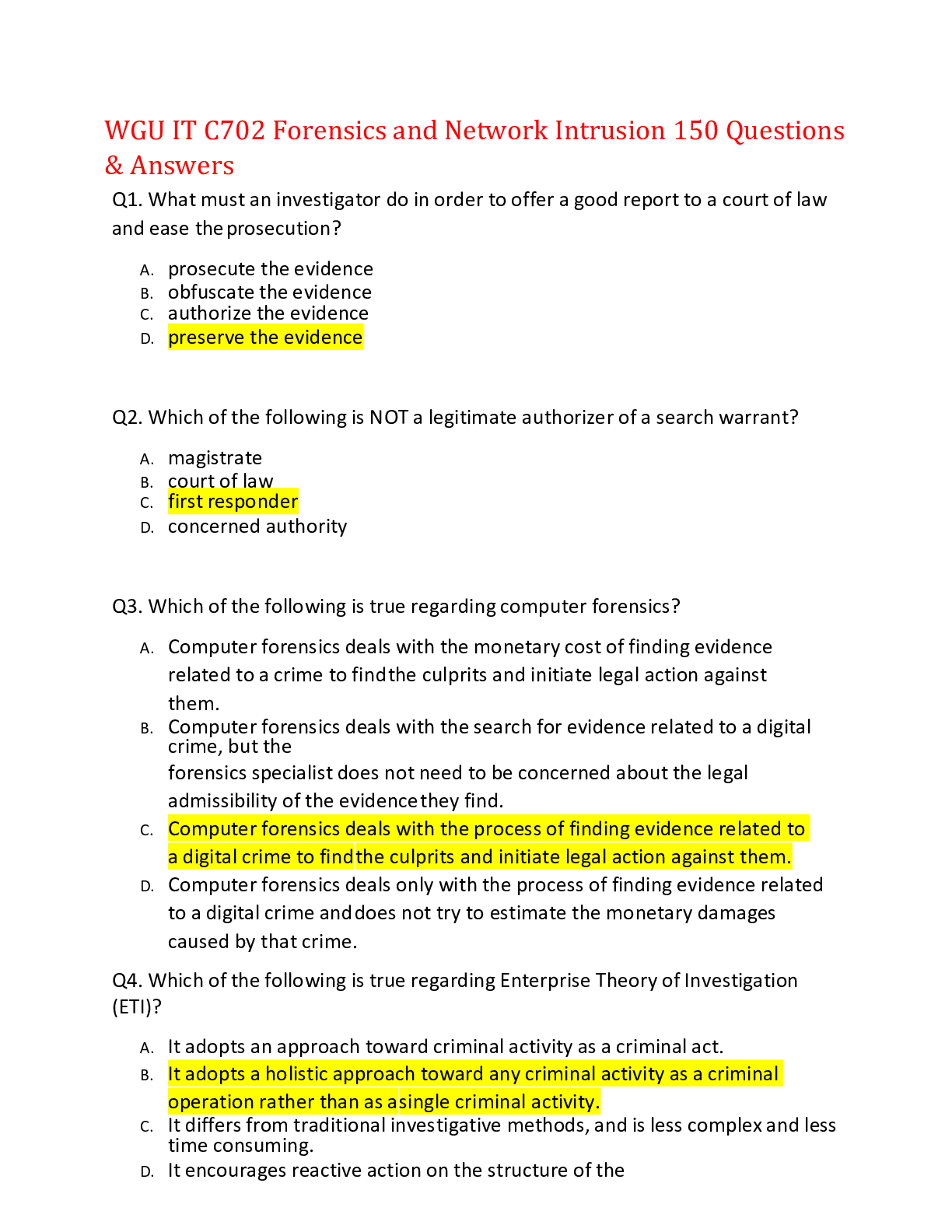
Reviews( 0 )
Document information
Connected school, study & course
About the document
Uploaded On
Feb 02, 2023
Number of pages
46
Written in
Additional information
This document has been written for:
Uploaded
Feb 02, 2023
Downloads
0
Views
53






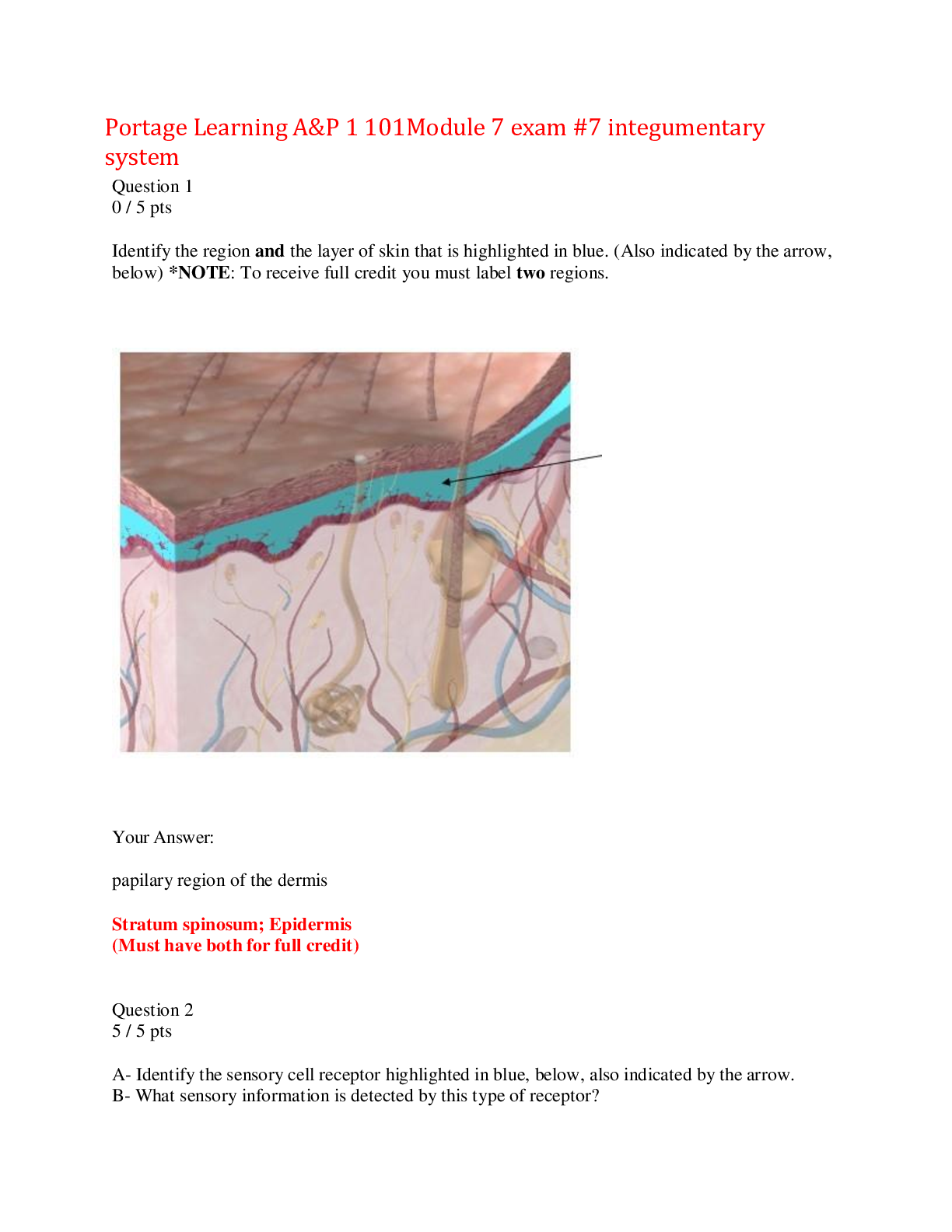







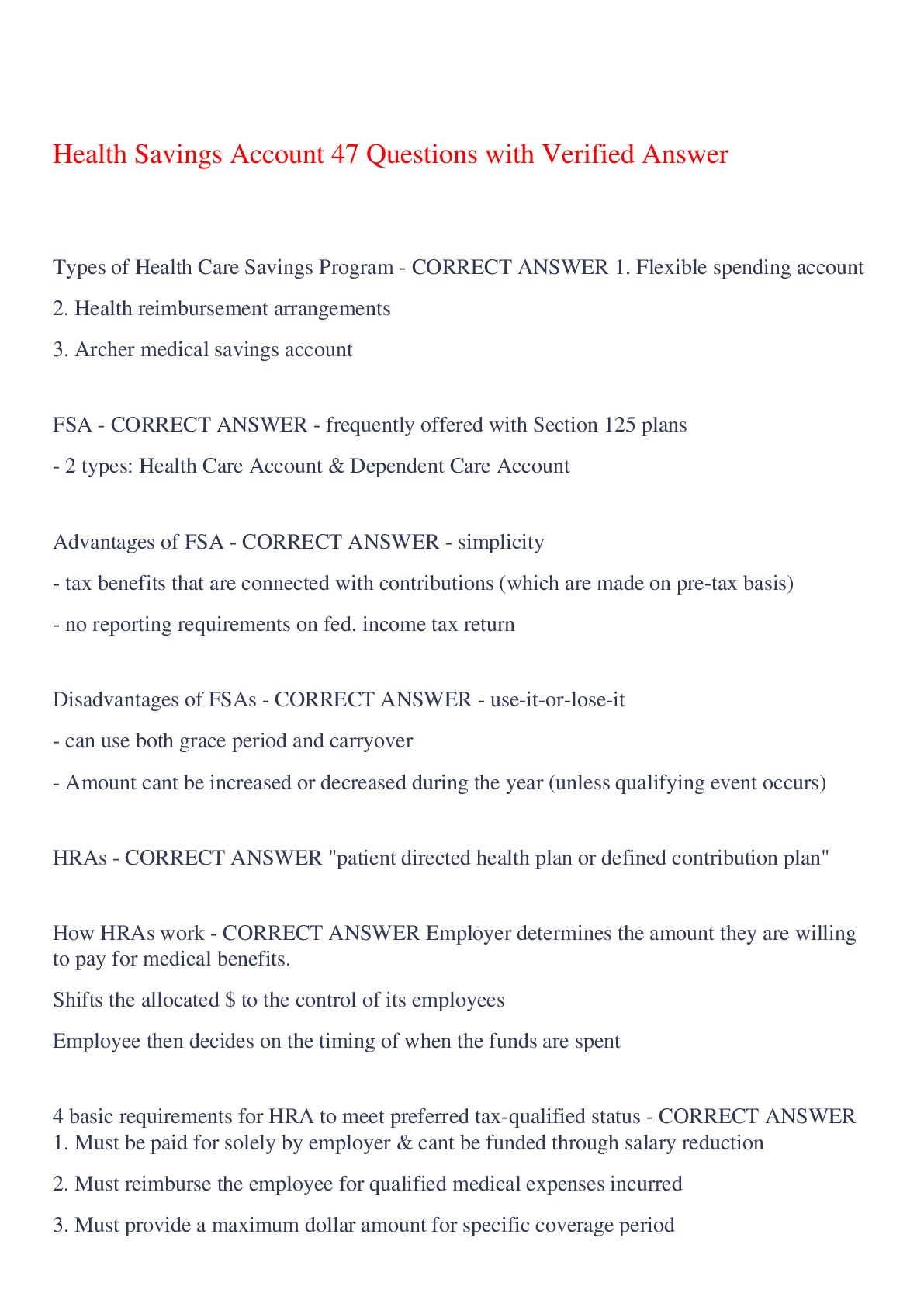


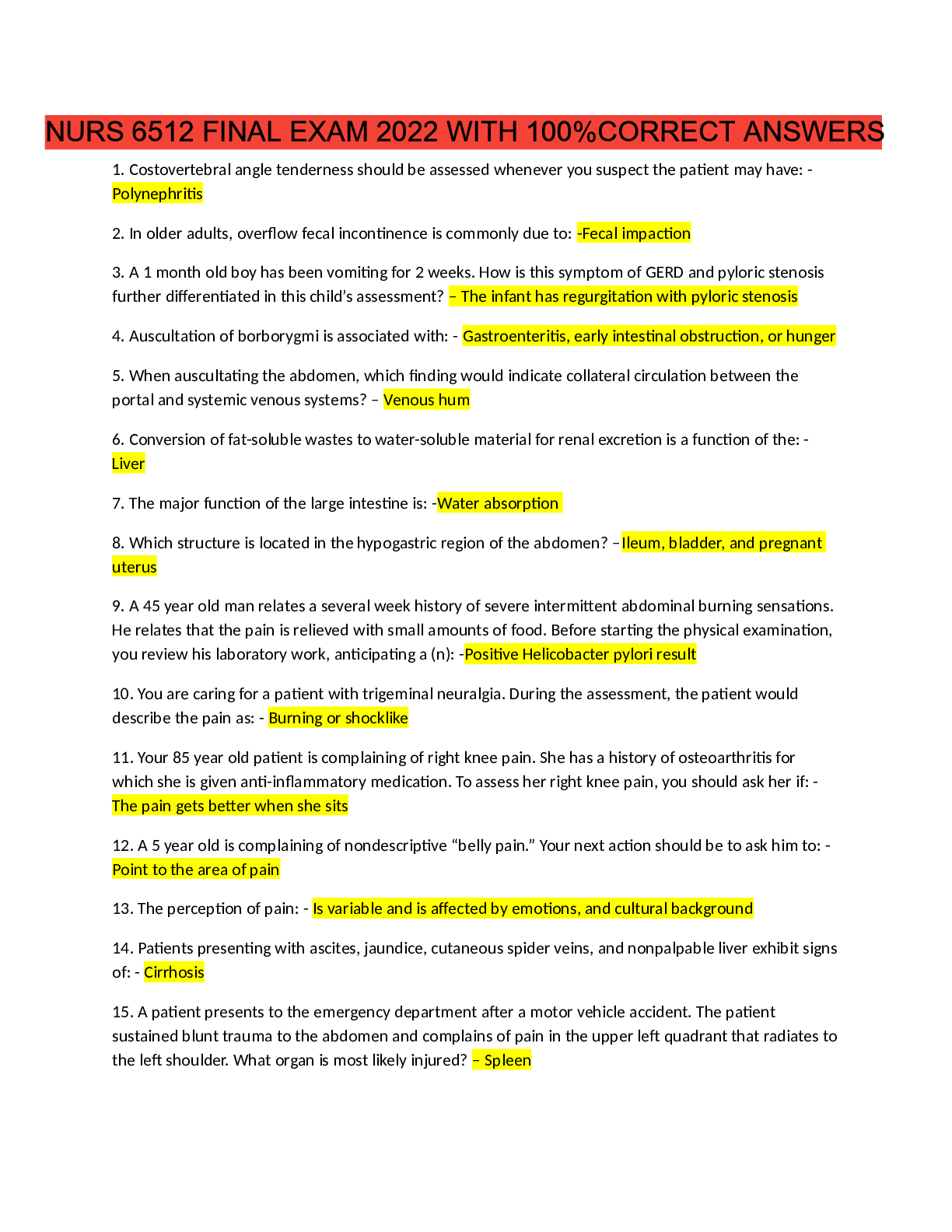
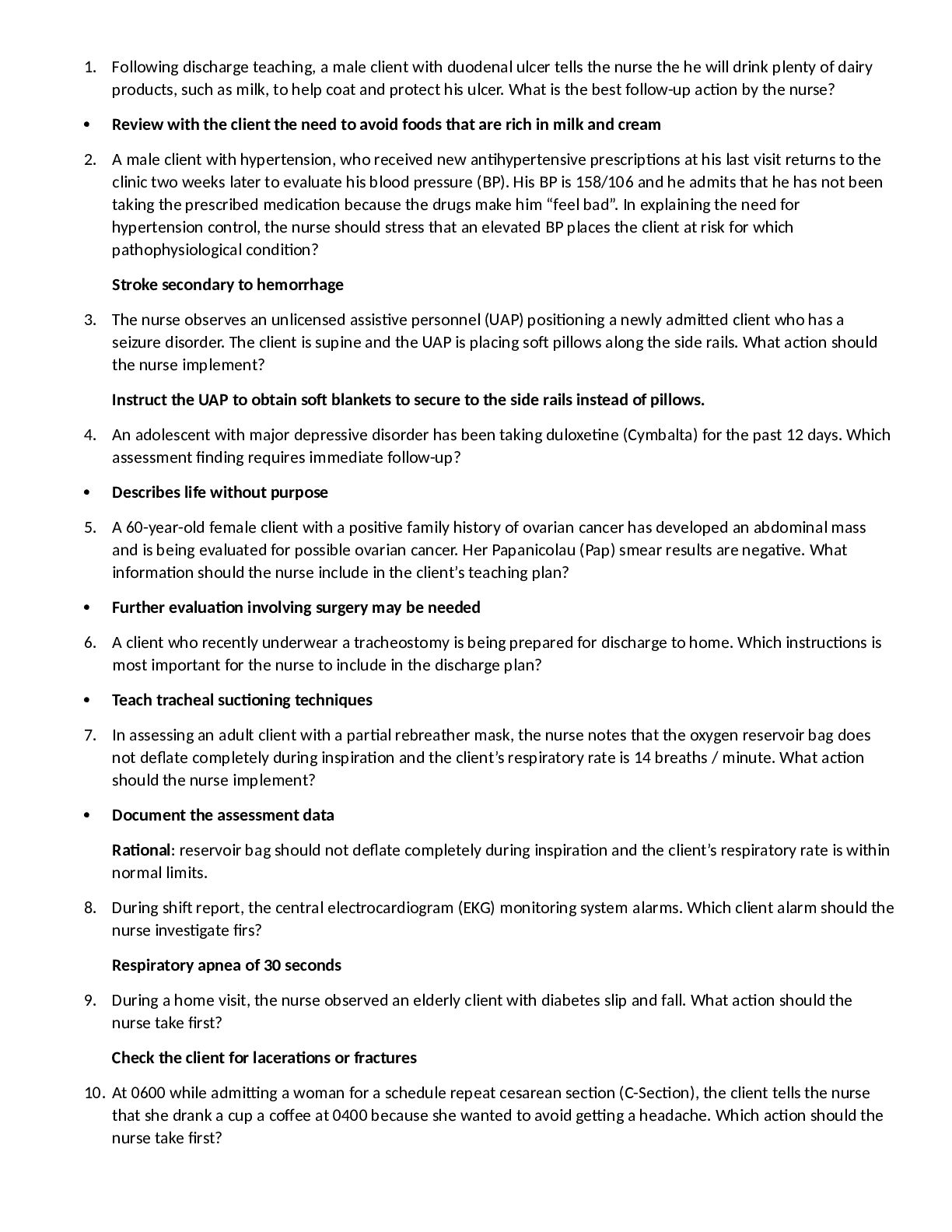
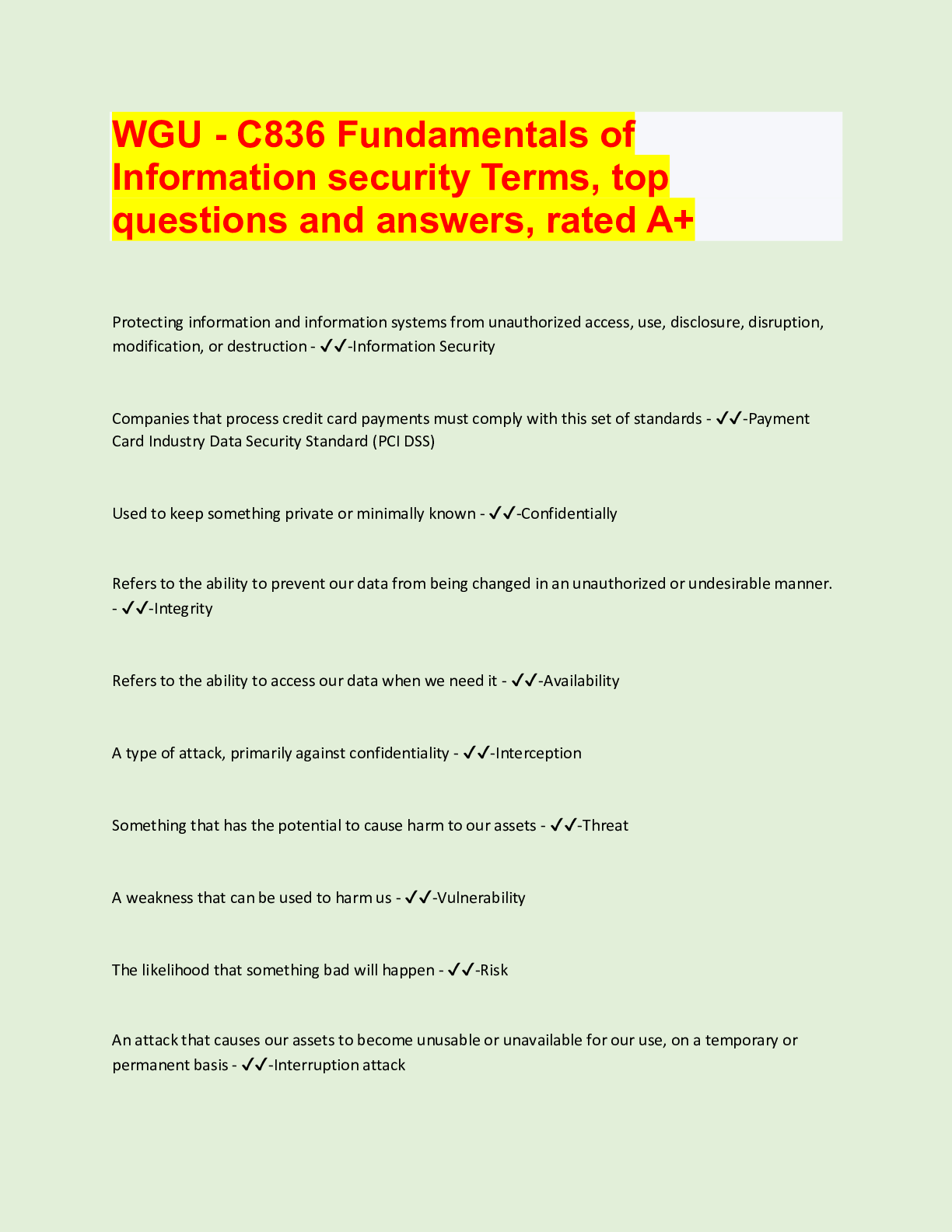
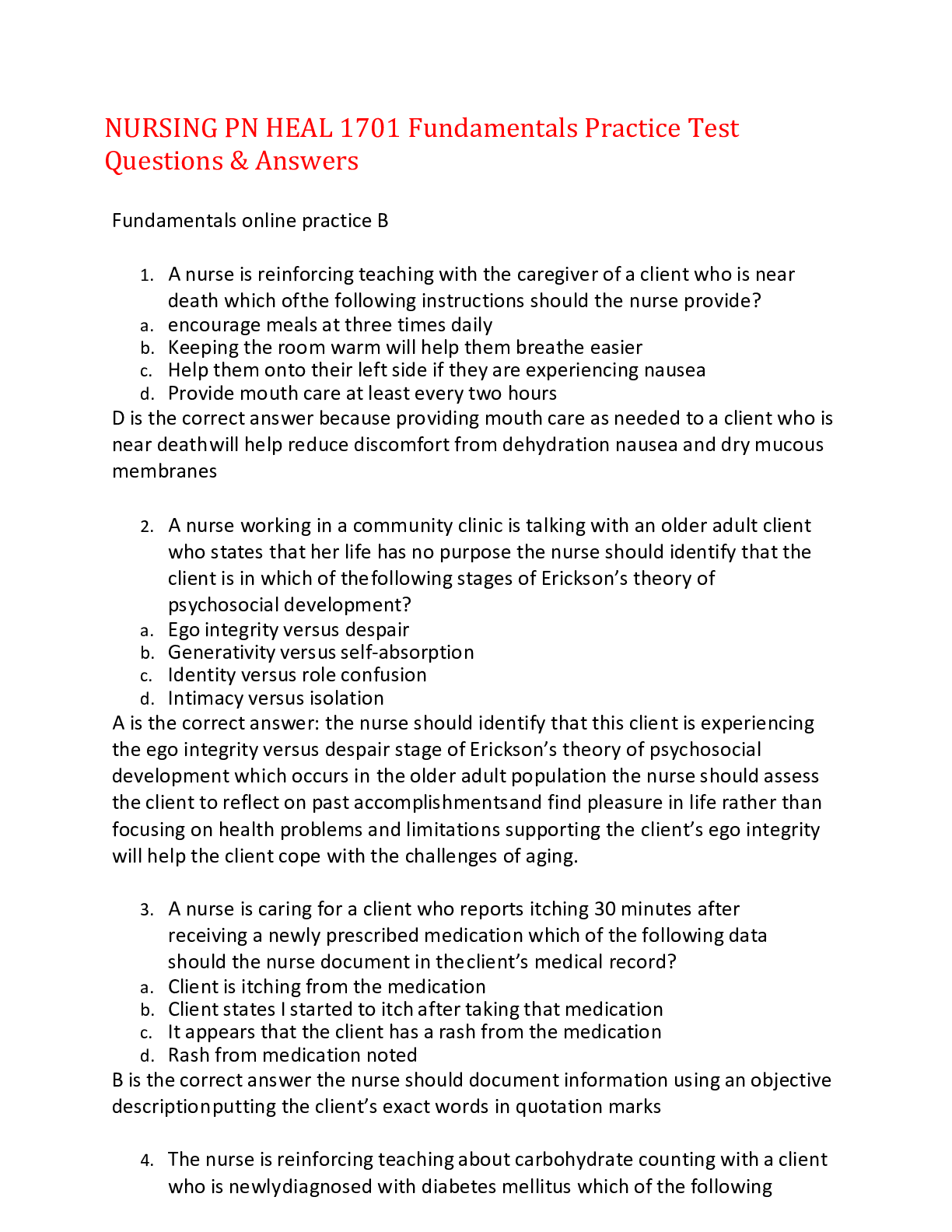
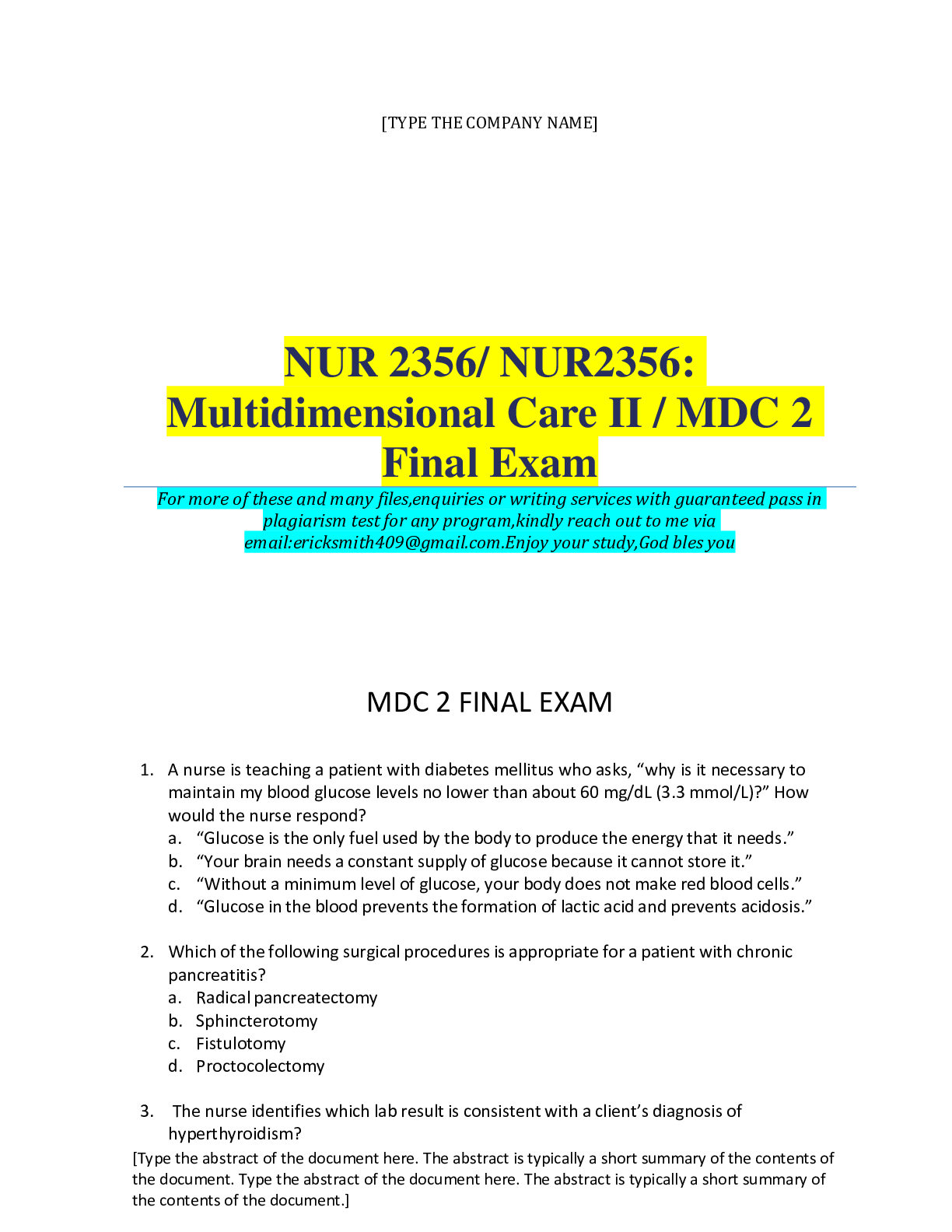





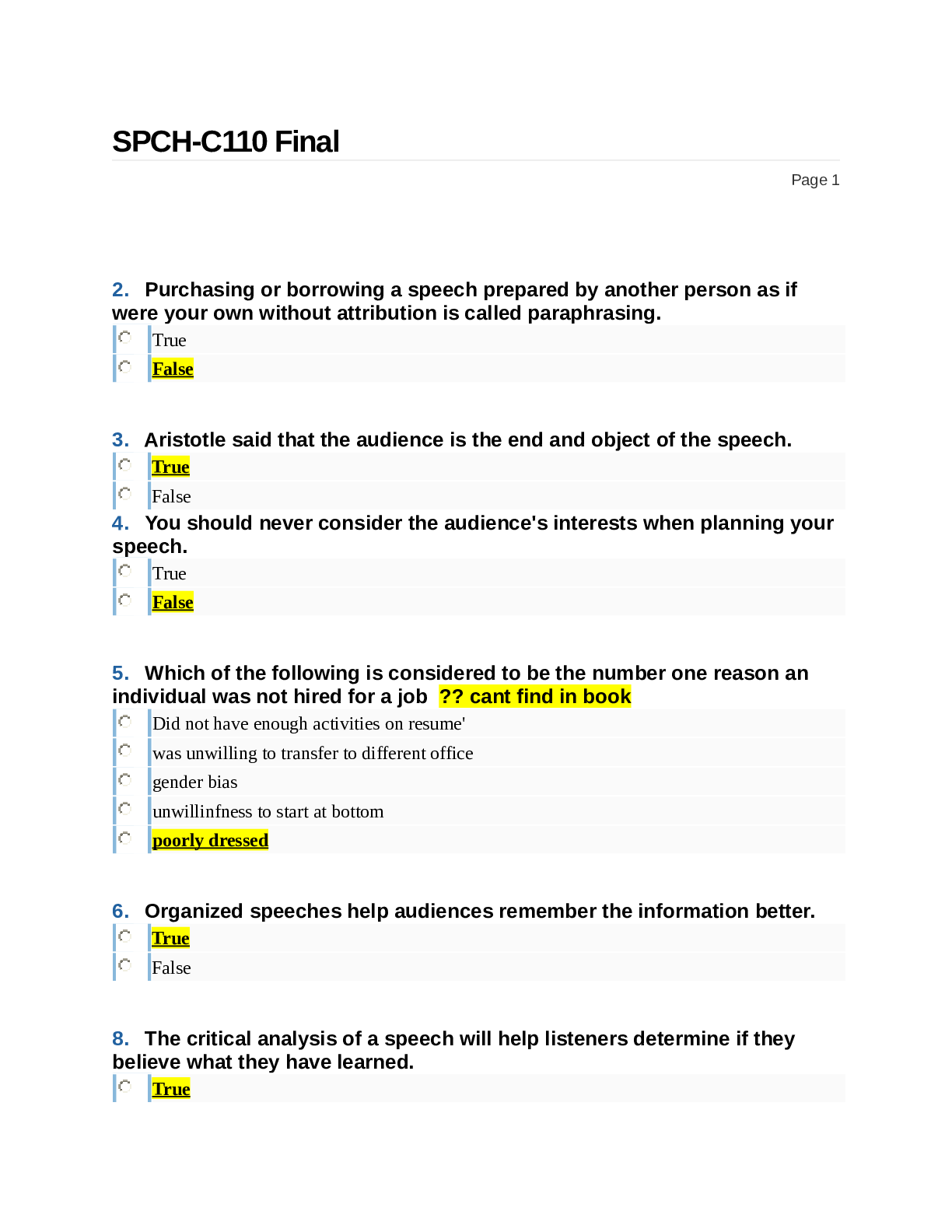


.png)
